Refining the sensory and motor ratunculus of the rat upper extremity using fMRI and direct nerve stimulation
- PMID: 17969116
- PMCID: PMC2519801
- DOI: 10.1002/mrm.21408
Refining the sensory and motor ratunculus of the rat upper extremity using fMRI and direct nerve stimulation
Abstract
It is well understood that the different regions of the body have cortical representations in proportion to the degree of innervation. Our current understanding of the rat upper extremity has been enhanced using functional MRI (fMRI), but these studies are often limited to the rat forepaw. The purpose of this study is to describe a new technique that allows us to refine the sensory and motor representations in the cerebral cortex by surgically implanting electrodes on the major nerves of the rat upper extremity and providing direct electrical nerve stimulation while acquiring fMRI images. This technique was used to stimulate the ulnar, median, radial, and musculocutaneous nerves in the rat upper extremity using four different stimulation sequences that varied in frequency (5 Hz vs. 10 Hz) and current (0.5 mA vs. 1.0 mA). A distinct pattern of cortical activation was found for each nerve. The higher stimulation current resulted in a dramatic increase in the level of cortical activation. The higher stimulation frequency resulted in both increases and attenuation of cortical activation in different regions of the brain, depending on which nerve was stimulated.
Copyright 2007 Wiley-Liss, Inc.
Figures
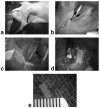



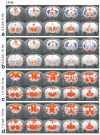
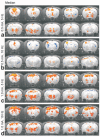
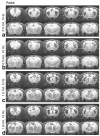
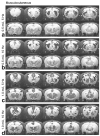
References
-
- Hyder F, Behar KL, Martin MA, Blamire AM, Shulman RG. Dynamic magnetic resonance imaging of the rat brain during forepaw stimulation. J Cereb Blood Flow Metab. 1994;14:649–655. - PubMed
-
- Hyder F, Rothman DL, Mason GF, Rangarajan A, Behar KL, Shulman RG. Oxidative glucose metabolism in rat brain during single forepaw stimulation: a spatially localized 1H[13C] nuclear magnetic resonance study. J Cereb Blood Flow Metab. 1997;17:1040–1047. - PubMed
-
- Keilholz SD, Silva AC, Raman M, Merkle H, Koretsky AP. Functional MRI of the rodent somatosensory pathway using multislice echo planar imaging. Magn Reson Med. 2004;52:89–99. - PubMed
-
- Keilholz SD, Silva AC, Raman M, Merkle H, Koretsky AP. BOLD and CBV-weighted functional magnetic resonance imaging of the rat somatosensory system. Magn Reson Med. 2006;55:316–324. - PubMed
-
- Paxinos G, Watson C. The rat brain in stereotaxic coordinates. Elsevier Academic Press; Boston: 2005.
Publication types
MeSH terms
Grants and funding
LinkOut - more resources
Full Text Sources
Medical

